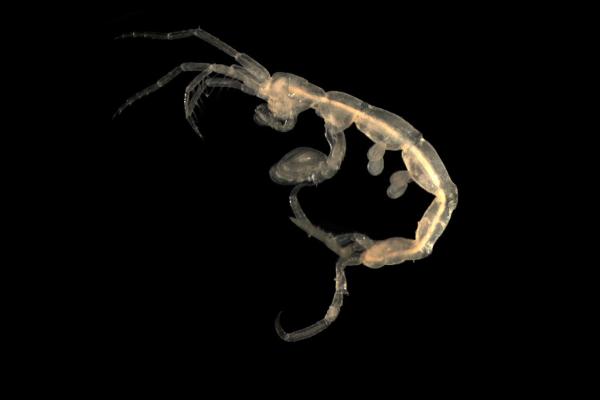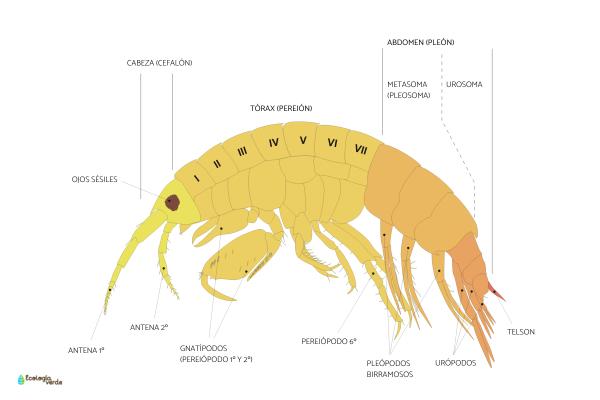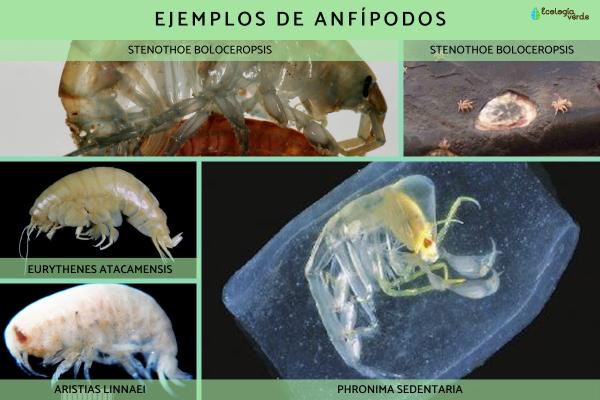Amphipods (order Amphipoda), commonly known as "sand fleas" or "scuds," are small crustaceans that are distributed worldwide. Thanks to their incredible evolutionary adaptability, amphipods have colonized a variety of habitats—from marine and freshwater environments to even terrestrial zones. There are both free-living and parasitic species, contributing to a remarkable diversity that has led many to call amphipods the “insects of the sea.”

Curious to learn what amphipods are? Read on for a full introduction to the definition, examples, and main characteristics of amphipods.
Amphipods, together with decapods (like crabs and shrimp) and copepods, are among the most diverse groups of crustaceans, with around 10,000 known species and more being discovered each year. Here are their most important characteristics:
Tiny Body Size: Most amphipods measure under 10 mm in length, with laterally compressed (flattened side-to-side) bodies ideal for their benthic lifestyle.
No Hard Carapace: Unlike many crustaceans, amphipods lack a protective shell; instead, their segmented bodies are covered by flexible coxal plates.
Simple Eyes: They have a single pair of simple eyes (not on stalks), distinguishing them from many other crustaceans.
Segmented Body: Their body is divided into three parts—head (cephalon), thorax (pereion), and abdomen (pleon)—with jointed appendages for locomotion, feeding, respiration, and reproduction.
Specialized Appendages: The thorax has 7 segments, each with a pair of legs called pereiopods (some with gills); the abdomen has 6 pairs of appendages—3 pairs of pleopods and 3 pairs of uropods, ending in a well-defined telson.
Ecological Importance: Amphipods play a crucial role in food webs, transferring energy and nutrients and serving as prey for fish, whales, birds, and larger crustaceans.
High Nutritional Value: They are easy to culture, making them a valuable food source in aquaculture industries.
Environmental Indicators: Amphipods are highly sensitive to pollution and are used as bioindicators in environmental impact and ecotoxicology studies.
Widespread Distribution: Found in marine, freshwater, brackish, and even some terrestrial ecosystems, including both planktonic and benthic forms.
High Reproductive Rate: Amphipods typically have short life cycles and very abundant populations.

The order Amphipoda is divided into five suborders: Hyperiidea, Ingolellidea, Caprellidae, Gammaridea, and Corophiidae. Gammaridea and Corophiidae account for about 92% of all amphipod species. Notable examples include:
Stenothoe boloceropsis: A symbiotic amphipod living on the sea anemone Boloceropsis platei.
Whale lice (Cyamidae): Ectoparasitic amphipods found on the bodies of whales.
Giant amphipod (Eurythenes atacamensis): A scavenger species endemic to the Atacama Trench, known to ingest microplastics.
Aristias linnaei: Recently discovered in the deep channels of Chile, possibly commensal with marine sponges or corals.
Phronima sedentaria: Females place their eggs inside other organisms, such as tunicates, using them as protective nurseries.
Amphipods can be found across the globe, with both free-living and parasitic species. They inhabit:
Marine ecosystems: From tidal zones to the deep sea, rocky substrates, sandy bottoms, shells, and coral reefs.
Freshwater and brackish environments: Including lakes, streams, reservoirs, and groundwater.
Terrestrial habitats: A few species thrive in moist soils or mosses.
Extreme environments: Some live in hot springs, hydrothermal vents, or even decomposing marine mammal carcasses.
Many amphipods form associations with other organisms, living as commensals or parasites with sea anemones, jellyfish, sponges, ascidians, mollusks, echinoderms, fish, and turtles.

Amphipods display a wide variety of feeding strategies:
Filter feeders: The most common type, feeding on suspended organic particles and plankton.
Scrapers: Grazing on biofilm, algae, or detritus from shells, rocks, and seaweed.
Scavengers: Many deep-sea and benthic amphipods feed on animal and plant remains.
Predators: Some families, such as Phoxocephalidae, prey on copepods, nematodes, and polychaetes; pelagic species often consume zooplankton.
Detritivores: Feeding on decomposing organic material.
Parasites: Some amphipods feed on host tissues, such as whale lice.
Amphipods are dioecious (separate male and female individuals), and most reproduce only once in their lifetime. During the breeding season, females release pheromones to attract males, who grasp the females with specialized appendages. Mating may occur just before or after the female molts. Fertilization is internal, with eggs kept in a brood pouch (marsupium) on the female’s underside until they hatch. The juveniles remain in the pouch until they are fully independent, undergoing direct development without a larval stage. In some species, parental care continues after juveniles leave the pouch.
Literature
Chiesa IL., Alonso GM. (2014). Amphipods Gammaridea and Corophiidea. Available at: https://www.researchgate.net/publication/311486887_Anfipodos_Gammaridea_y_Corophiidea
Häussermann V. and Vader W. (2015). A new Stenothoe species (Crustacea: Amphipoda: Stenothoidae) living on Boloceropsis platei (Anthozoa: Actiniaria) from Chilean Patagonia. Available at: https://www.researchgate.net/publication/276151222_A_new_Stenothoe_species_Crustacea_Amphipoda_Stenothoidae_living_on_Boloceropsis_platei_Anthozoa_Actiniaria_from_Chilean_Patagonia
National Museum of Natural History. (2015). A new crustacean discovered in Aysén. Available at: https://www.mnhn.gob.cl/noticias/un-nuevo-crustaceo-descubierto-en-aysen
National Museum of Natural History. (2015). A brief introduction to amphipods. Available at: https://www.mnhn.gob.cl/noticias/una-breve-introduccion-los-anfipodos
National Museum of Natural History. (2021). The scavenging amphipod of the Atacama Trench now has a name! Available at: https://www.mnhn.gob.cl/noticias/el-anfipodo-carronero-de-la-fosa-de-atacama-ya-tiene-nombre
Viñas MD., Colombo GA., and Padovani L. (2016). Hyperid Amphipods. Dis
animal tags: Amphipods
We created this article in conjunction with AI technology, then made sure it was fact-checked and edited by a Animals Top editor.